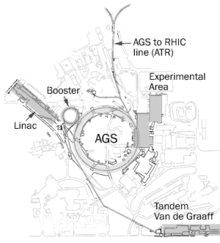Alternating Gradient Synchrotron
The Alternating Gradient Synchrotron (abbreviation: AGS ) is a synchrotron - particle accelerator with 800 m circumference at the Brookhaven National Laboratory (BNL).
history
After the construction of the Cosmotron , plans began at the BNL to build a stronger successor, although difficulties arose. While the cross-section of the circumferential ring on the Cosmotron already had dimensions of around 20 cm × 60 cm, the successor would have required around 50 cm × 150 cm. The result would have been a very large weight of the electromagnets and corresponding costs. One way out was a concept by Courant , Livingston and Snyder to closely focus the circulating particles by means of alternating magnetic field gradients , the so-called “strong focus”, which allowed the circumferential ring to shrink to a cross-section of around 5 cm. This principle was tested for the first time with the construction of a 1.3 GeV electron synchrotron in 1954 at the BNL.
Almost at the same time, the planning for the construction of the Proton Synchrotron (PS) took place at CERN . The principle of strong focus was adopted there, so that with the AGS and the PS two very similar machines were created. The PS went into operation in November 1959 and the AGS followed a few months later.
On July 29, 1960, the AGS reached the planned proton energy of 33 GeV , thus replacing the proton synchrotron as the world's most powerful particle accelerator.
The Relativistic Heavy Ion Collider (RHIC) went into operation at the BNL in 2000, and the AGS has served as a pre-accelerator ever since.
business
In the AGS, not only protons but also heavy ions such as gold and iron are accelerated. Since 1984, the AGS has been able to generate polarized protons up to an energy of 16.5 GeV.
When operating as a pre-accelerator of the RHIC, the AGS is only used in relatively short periods of a few minutes, about eight to ten hours apart. During the rest of the time, the AGS is available for other purposes.
Web links
Individual evidence
- ^ ED Courant and HS Snyder: Theory of the Alternating-Gradient Synchrotron . In: Annals of Physics . 281, No. 1-2, 2000, pp. 360-408. doi : 10.1006 / aphy.2000.6012 .
- ^ BNL: Brookhaven History - The Alternating Gradient Concept ( English ) Retrieved on Nov. 28, 2009.
- ^ Ernest Courant, BNL: Brookhaven and CERN: the AGS and the PS ( English ) Oct. 19, 2007. Retrieved Nov. 28, 2009.
- ↑ a b BNL: Brookhaven History - Alternating Gradient Synchrotron ( English ) Retrieved on Nov. 28, 2009.
- ↑ Mitsuyoshi Tanaka / AGS Department, BNL: The BNL AGS Accelerator Complex - Status And Future Plans ( English ) July 1997. Retrieved November 28, 2009.

